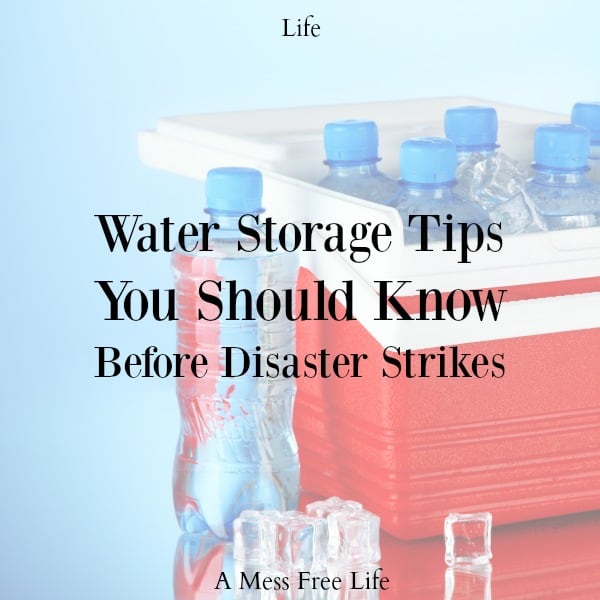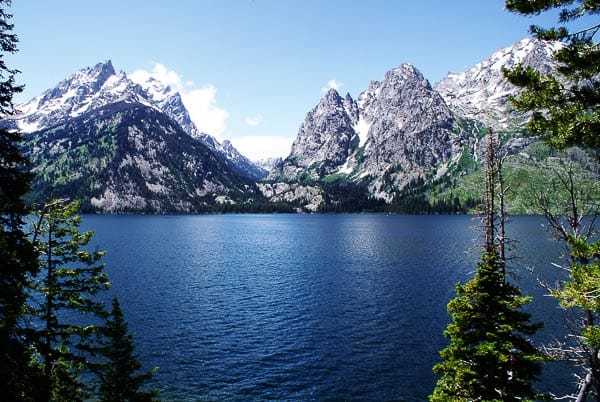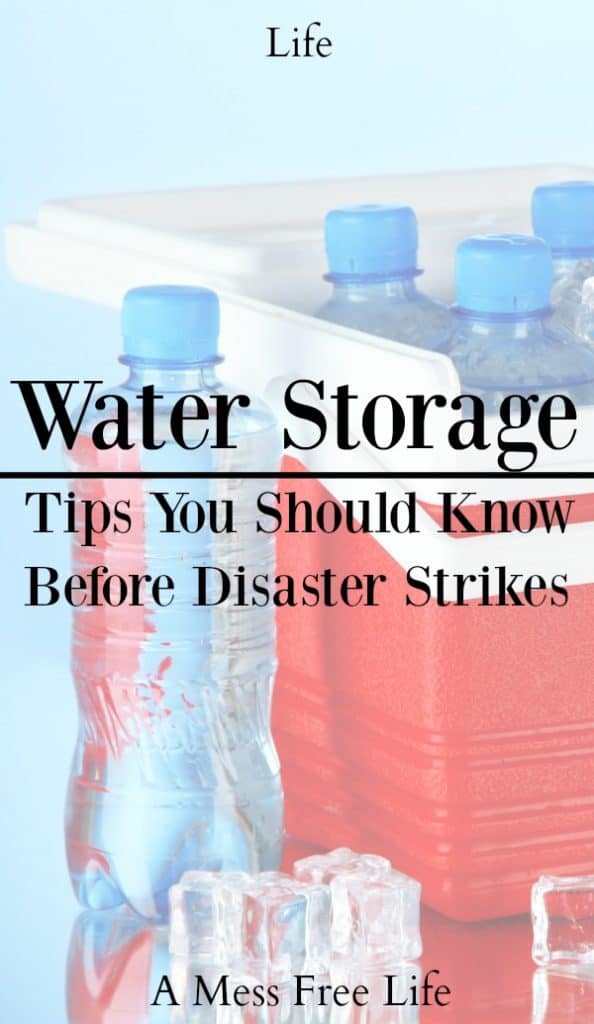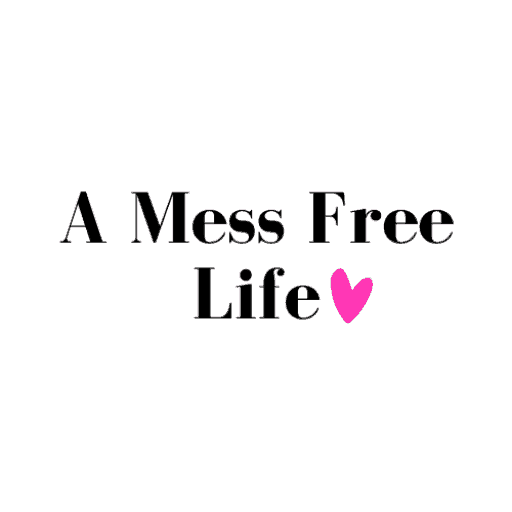A Mess Free Life may collect a share of sales or other compensation from the links on this page.
I’m a huge proponent of emergency preparedness. If national disasters like Hurricane Katrina, major ice storms which leave people in the dark for weeks, or major blizzards which leave you cut off from the rest of the world for days don’t provide a good enough reason to get prepared, I don’t know what will.
In the past, I’ve shared with you the importance of being prepared and creating a realistic plan in case of an emergency that will keep your family safe.
That’s an important first step, but don’t stop there! Ensuring your family has an adequate supply of drinkable water is the next step in your emergency preparedness plan.
Table of Contents
WATER STORAGE TIPS SO YOUR FAMILY IS PREPARED
The simple fact is we can’t live without water.
The human body can only survive 3-4 days without water although some people have been known to survive up to 7 days. That’s based primarily on the weather conditions, and if you’re in an extreme cold or hot environment. Either way, death by dehydration is not pretty.
The CDC recommends the following:
“Drinking water can prevent dehydration, a condition that can cause unclear thinking, result in mood change, cause your body to overheat, constipation, and kidney stones.
In an emergency, drink at least 2 quarts of water a day, 3 to 4 quarts a day if you are in a hot climate, pregnant, sick, or a child. If supplies run low, don’t ration water. Drink the amount you need today and look for more tomorrow. Don’t risk dehydration.”
In a crisis, having a supply of clean water to drink, cook and bathe with is a top priority.
We’ve all seen the videos of hurricane disasters like Katrina, where so many people were unprepared and lacked access to clean water. If a natural or man-made disaster strikes your community, access to clean water might be temporarily unavailable. What would you do?
Now is the time to think about it and to create a plan so you have an adequate supply of drinking water available for you and your family.
Preparing your family starts with a plan, but once your emergency plan is developed, your next priority is taking the steps to store emergency water supplies, and learning other useful tips for accessing water in an emergency.
HOW MUCH WATER DO YOU NEED?
- Store at least 1 gallon of water per person per day for a minimum 3-day supply. For example, this means a family of 4 needs 12 gallons.
- Be sure to account for pets; dogs and cats typically need 1 gallon each per day.
- Children, the elderly/sick and nursing mothers may require more than the average. Take into account your family’s particular needs.
WATER STORAGE
Experts recommended you purchase food-grade water storage containers from surplus or camping supplies stores to use for water storage.
There are many options out there for water storage. If you have the room, something like the Augason Farms – Emergency Water Storage Kit holds up to 55 gallons for long-term storage. This option can be pricey for some people.
Other options for people who don’t have that kind of room might be the 8 Pack Water Brick. Requires less space, but still a bit costly.
I live in a multi-level townhouse and don’t have room for either option. I have store-bought water on hand that I rotate every six months, but found this handy water storage device that works fabulously for people like me that don’t have the room for long term storage but might need to store water immediately.
It’s cost-effective too. It’s the WaterBOB. It’s a one time, disposable and easy to use device, that stores up to 100 gallons of water right in your bathtub.
It’s vital you listen to reports from local officials for advice on water precautions in your home. It may be necessary to shut off the main water valve to your home to prevent contaminants from entering your piping system. If that were the case you would not use the device listed above and would only use your long term water storage or devices below to treat the water.
No matter what method you choose, always ensure the following:
- Store water in a cool, dark place in your home, office, or car.
- Replace water every six months and be sure to check expiration dates on store-bought water.
If you chose to use your storage containers, choose two-liter plastic soft drink bottles – not plastic jugs or cardboard containers that have had milk or fruit juice in them.
Milk protein and fruit sugars cannot be adequately removed from these containers and provide an environment for bacterial growth when water is stored in them.
Cardboard containers also leak easily and are not designed for long-term storage of liquids. Also, do not use glass containers, because they can break and are heavy.
STORING WATER IN PLASTIC BOTTLES
Follow these steps for storing water in plastic soda bottles:
- Thoroughly clean the bottles with dishwashing soap and water, and rinse completely, so there is no residual soap.
- Sanitize the bottles by adding a solution of 1 teaspoon of non-scented liquid household chlorine bleach to a quart of water. Mix the sanitizing solution in the bottle so that it touches all surfaces including the cap. After sanitizing the bottle, thoroughly rinse out the sanitizing solution with clean water.
- Fill the bottle to the top with regular tap water. If the tap water has been commercially treated from a water utility plant with chlorine, you do not need to add anything else to the water to keep it clean. If the water you are using comes from a well or water source that is not treated with chlorine, add two drops of non-scented liquid household chlorine bleach to the water. Let the water stand for 30 minutes before using.
- A slight chlorine odor should be noticeable in the water, if not, add another dose of bleach and allow the water to stand another 15 minutes.
- Tightly close the container using the original cap. Be careful not to contaminate the cap by touching the inside of it with your finger. Place a date on the outside of the container so you can know when you filled it. Store in cool, dark place.
WATER PURIFICATION
There are other methods for water purification, for example, water purification liquid which allow you to store water for up to 5 years instead of the six months.
I have the LifeStraw as one of my portable water filtration systems and love the peace of mind I have by just being able to throw it into a backpack and go if the need arises. I have two for each member of my family.
You can also purchase water purification tablets and systems for when you are on the go and can’t transport your water supply with you. For example, in the case of an emergency evacuation, the larger storage container methods above might need to be left behind due to limited availability to transport. These can be used either on the go or if you are sheltering in place.
There are also mini water filtration systems you can throw in a backpack and go. These are good when you have multiple people who will require drinking water.
No matter what you decide to choose, please think about a fulfilling the requirements to ensure you have the amount of water necessary for your family for a three-day period or longer.
FINDING CLEAN WATER
In an emergency, you might need to locate other sources of clean and safe water. Here is a list of where you can look for clean water both inside and outside of your home.
REMEMBER: DO NOT DRINK water that has an unusual odor or color, or that you suspect might be contaminated with fuel or toxic chemicals. This water UNDER ANY CIRCUMSTANCES CANNOT be made safe.
POSSIBLE SOURCE OF WATER
Inside the Home
Water from your home’s HOT water tank
Melted ice cubes made with water that was not contaminated
Liquid from canned fruit and vegetables
Outside the Home
Rainwater
Streams, rivers, and other moving bodies of water
Ponds and lakes
Natural springs
Water from some sources outside the home can be made safe for drinking by following the instructions on a water purification products or by visiting the CDC’s Website.
CONCLUSION
The government is not going to be able to care for all those who need it in a disaster situation. We’ve seen that time and time again.
Take responsibility for your family and make sure you have the water you need to live through a disaster.




